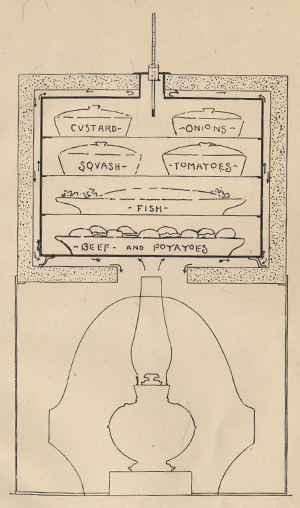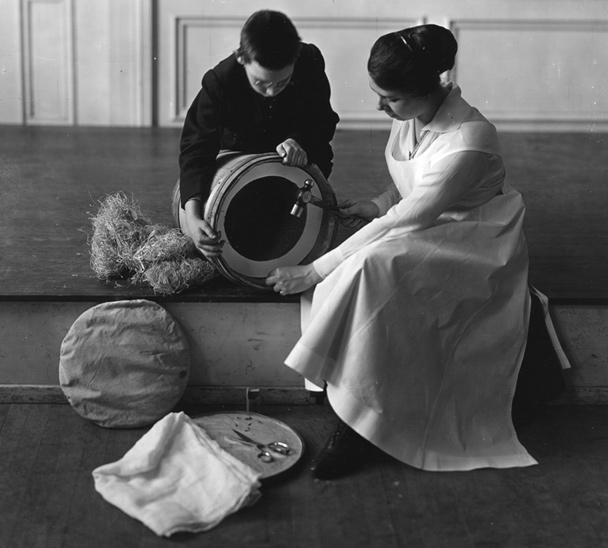
In the beginning, all cooking was slow. Open fires and heavy cooking pots made the quick sautés and crisp tenderness of contemporary cuisine impossible. Almost total lack of sanitation, too, made it advisable to cook food for a long time. In the mid-19th century, enclosed stoves sped up processes slightly, but meal preparation still required much vigilance. Stoves needed stoking and roasts needed basting in the dry heat of the wood stove. For most middle class American and British families, all this work was done by someone hired for the purpose—the persona known as cook. The hard work of meal production was left to those who had little time to devise easier methods.
At the end of the 19th century, however, pot-watching earned a potent critic in the wiry form of Ellen Swallow Richards. An MIT-trained chemist, Richards popularized the Aladdin Oven (pictured at right), invented by Edward Atkinson. The Aladdin used one heat source (an oil lamp) to cook several dishes in separate compartments, such as beef and potatoes closest to the heat source and a pot of custard farthest away. Richards praised the Aladdin because it conserved both fuel and human energy. Its slow cooking provided another economy in that it broke down cheaper, tougher cuts of meat for tastier, less expensive meals. One company, Diller Manufacturing, claimed that its version of the fireless cooker preserved more of food’s weight and that the flavor “is cooked into the food…instead of into the surrounding atmosphere.”
The fireless cooker was not really a new idea. It simply brought indoors the technology of the luau pit or the clambake. Both these ancient methods cooked ingredients in insulated pits through the use of conserved heat.
To encourage its use in American homes, Richards featured the oven in her New England Kitchen, a short-lived restaurant designed to introduce working-class Boston to cheap, nutritious cooking. She also put the Aladdin to work in an exhibit at the World’s Columbian Exposition of 1893, held in Chicago. There, the Aladdin fed thousands of visitors on slow-cooked fare. Because Richards was the founding figure of home economics, the slow cooker became part of education programs in this field. Home economics extension agents in the early 1900s brought stoves out to meet the people, teaching women to build their own with simple materials found on most farms.
One commercial version was the Duplex, produced in the 1910s by the Durham Manufacturing Company of Muncie, Indiana. The Duplex was a large cabinet with two insulated wells for slow cooking. It also came with heatable metal disks to be inserted above and below dishes for baking, a feature the Aladdin lacked. However, owners of the Duplex had to attach it to the only electrical source common to homes in this era—the light socket—which potentially meant that cooking was done in the dark.
Dishes had to be precooked to some degree before they were lowered into the wells. The Duplex was useful rather than magical. A promotional cookbook warned: “You can not put hastily and poorly prepared dishes in the fireless stove and take them out as delicious triumphs of culinary art.” What you could purportedly create, over the course of four or five hours, were dishes typical of middle class foodways of the era, such as veal loaf, escalloped corn, and a nice steamed pudding.

Fireless cookers became popular during the First World War when fuel prices rose and a system of voluntary rationing made the more tender cuts of meat hard to get. One popular version was the hay box (above), constructed of a cooking pot nestled inside a hay-stuffed wooden crate. As with the Duplex, food required some precooking. The cooking process had to start with braising or boiling on a stovetop before the cooking could continue slowly in the hay box.
One common problem with the hay box was that the insulation could come loose and end up as unwanted garnish to the meal. Hay insulation could also become musty, which would impart a stale flavor to the food. Most problematic was the danger of a spark at the bottom of the pan setting the box on fire. For these reasons, many women who at first had been excited about the method lost interest and, “If the family should move house, [the hay box] is left behind as a useless piece of lumber.” Like the crockpots that lurk in the backs of many contemporary cupboards, early slow cookers also waxed and waned in popularity.


 Pinterest
Pinterest


